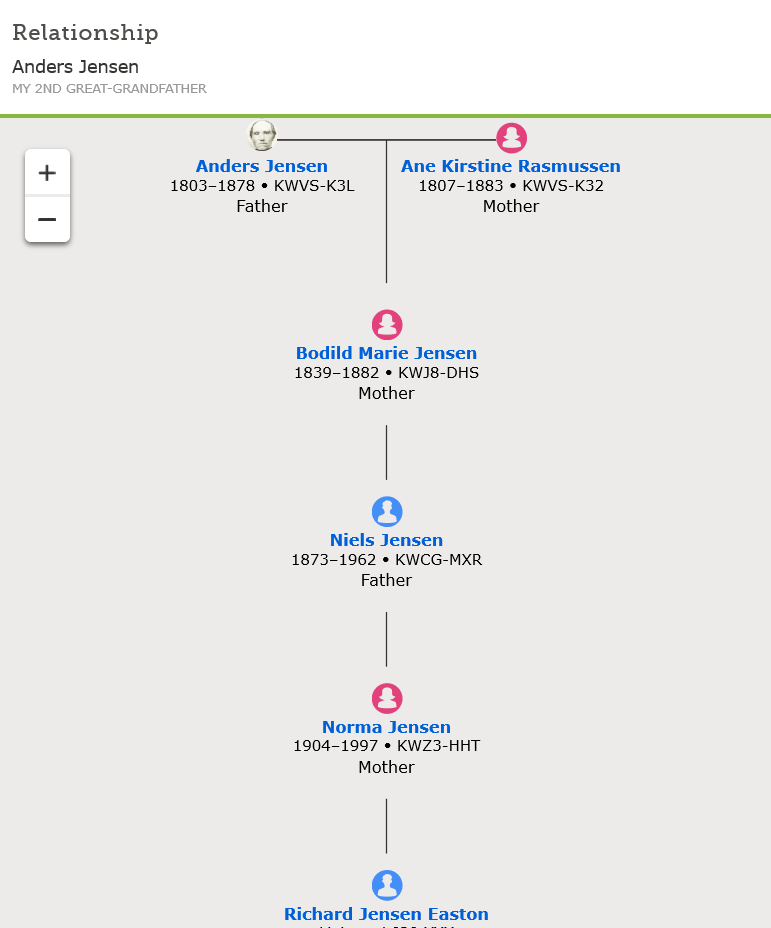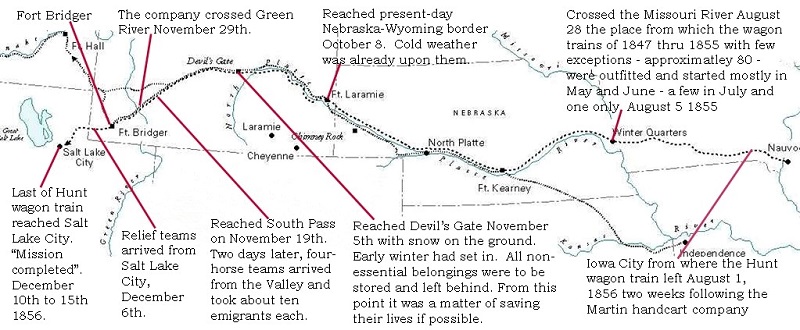
Alternate names form Anders are the following: Andrus Jensen, Anders A. Jensen, Anders Andersen Jensen,
Andors Jensen and Andrew Jensen
Anders was born on December 29, 1803 in Raadved, Skandeborg County, Denmark and married Anna
Christina Rasmussen on November 24, 1833 in Hansted Parish, Skanderborg County, Denmark. Anders
had two other wives: Else Andersdatter who he married on December 1, 1865 and Bodild Maria Anderson.
Anders Jensen had 13 children, all born in Skanderborg County, Denmark: Karen born March 23, 1834; Rasmus A born
October 1, 1835; Jens born February 24, 1837; Christina born August 6, 1837; Anders Anderson born
March 23, 1839; Jorgan Peder born October 27, 1844; Bodild Marie born August 21, 1839; Jens Neils born
February 24, 1837; Mattie Cathrine born November 23, 1848; Anna Margaret born July 17, 1850; and Mariane
born on March 13, 1852. Anders and Bodil Marie had 4 children born in Kundy, Holbeck, Denmark: Anna Sophia
born on February 3, 1873; Susanne Marie born on April 18, 1870; Jens Ole born on January 14, 1879 and Jacob born
on April 13, 1883.
Anna, Anders and family migrated from Denmark and spent some time in Grant Township, Grundy
County, Iowa. Anders and Bodild had two sons that were born there: Hans Johnson on February 26, 1883 and
Peter Johnson on February so, 1885. From there they traveled as part of the Willie Handcart Company to
Salt Lake City and then onto Parowan, Iron County, Utah.
James G. Willie Company Handcart Company (1856)


The ship Thornton, carrying the emigrants who became the Willie Company, did not leave England until May 4. The
leader of the Latter-day Saints on the Thornton was James G. Willie. The Willie roster shows Anders and Anna as members
along with Michael and Anton who are listed as their sons. Another three weeks passed before the Horizon,
carrying the emigrants who formed the Martin Company, departed. The late departures may have been the result of
difficulties in procuring ships in response to the unexpected demand, but the results would be tragic.
The ship Thornton, Captain Collins, cleared on May 3, and sailed on the 4th for New York, with 764 souls of
the Saints on board, of whom 163 where from the Scandinavian Mission. This company is under the presidency of Elders
James G. Willie, Millen Atwood, Jacob A. Ahmansen, and Moses Clough. Elders Willie, Atwood, and Clough arrived
in England January 5, 1853; and consequently have been laboring in the ministry, in this country, nearly three
years and four months. Elder Ahmansen was out among the first who received the gospel in Scandinavia. He was baptized
by Elder E. Snow, when the gospel was first carried by him to Denmark. Since that time he has labored faithfully in
the ministry, and held responsible positions in the Scandinavian Mission. Elders John Kelly, late president of the
Cheltenham Conference, A. M. Findlay, formerly of the East India Mission, and John Chislett, who has been laboring
in the Swiss Mission, also sailed in the Thornton. These brethren have all been faithful and diligent in the ministry,
and have left their fields of labor to go home to Zion with our blessing and they have our prayers for their future
success and welfare."
The ship Thornton cleared from Liverpool, May 3rd, 1856, and sailed on the fourth for New York with seven
hundred and sixty-four Saints on board, of whom one hundred and sixty-three were from the Scandinavia Mission; four
hundred and eighty-four of the total number were Perpetual Emigration Fund emigrants, expected to cross the
plains with hand-carts. The company was placed in charge of Elders James G. Willie, Millen Atwood, Jacob A.
Ahmanson and Moses Clough. Elder John Kelley, A. M. Findlay, (formerly of the East India Mission) and John Chislett,
of the Swiss Mission, also sailed in the Thornton. Soon after leaving Liverpool the emigrants were divided into
seven wards or districts, over each of which a presiding officer was appointed. During the voyage Captain Collins
was very kind to the emigrants, allowing them a great many extra privileges which were duly appreciated by them.
He also gave the elders full liberty to preach and hold meetings on board as often as they pleased, and frequently he,
together with the ship's physician, and other officers were attentive listeners to the preaching and joined in
singing the songs of Zion. Considerable sickness prevailed among the emigrants of whom a number were old and sickly,
Seven deaths, three births and two marriages took place on board
They landed in New York City On June 14, 1856 and proceeded from there by train to Dunkirk, New York, along Lake Erie
Cleveland, Ohio and then to Toledo where they met up with the Martin Company. From there the two companies traveled by rail to
Chicago, Illinois onto Rock Island, Illinois and on to Iowa City, Iowa arriving on June 26. From there they traveled to
Des Moines to Council Bluffs, Iowa and finally to Florence, Nebraska that was know as Winter Quarters. On August 17, 1856
the Handcart Company left Florence, Nebraska on it's trek to Salt Lake City.
The 4th handcart company (Willie Company) which had about 500 individuals, 100 handcarts, and 5 wagons
in the company when it began its journey from the outfitting post at Iowa City, Iowa
With slow communications in the era before the transatlantic telegraph, the Church agents in Iowa City were
not expecting the additional emigrants and had to make frantic preparations for their arrival. Critical weeks were
spent hastily assembling the carts and outfitting the companies. When the companies reached Florence, additional
time was lost making repairs to the poorly built carts.
Prior to the Willie Company departing Florence, the company met to debate the wisdom of such a late departure.
Because the emigrants were unfamiliar with the trail and the climate, they deferred to the returning missionaries
and Church agents. One of the returning missionaries, Levi Savage, urged them to spend the winter in Nebraska. He
argued that such a late departure with a company consisting of the elderly, women and young children would lead to
suffering, sickness and even death. All of the other Church elders argued that the trip should go forward, expressing
optimism that the company would be protected by divine intervention. Some members of the company, perhaps as many as
100, decided to spend the winter in Florence or in Iowa, but the majority, about 404 in number (including Savage)
continued the journey west. The Willie Company left Florence on August 17 and the Martin Company on August 27.
Two ox-wagon trains, led by captains W.B. Hodgett and John A. Hunt, followed the Martin Company.
Near Wood River, Nebraska, a herd of bison caused the Willie Company's cattle to stampede, and nearly 30 cattle
were lost. Left without enough cattle to pull all of the wagons, each handcart was required to take on an additional
100 pounds (45 kg) of flour.
In early October the two companies reached Fort Laramie, Wyoming, where they expected to be restocked with
provisions, but no provisions were there for them. The companies had to cut back food rations, hoping that their
supplies would last until help could be sent from Utah. To lighten their loads, the Martin Company cut the luggage
allowance to 10 pounds (4.5 kg) per person, discarding clothing and blankets that soon would be desperately needed.
On the morning of October 7 the first rescue party left Salt Lake City with 16 wagon-loads of food and supplies,
pulled by four-mule teams with 27 young men serving as teamsters and rescuers. The party elected George D. Grant as
their captain. Throughout October more wagon trains were assembled, and by the end of the month 250 relief wagons
were on the road.
Meanwhile, the Willie and Martin companies were running out of food and encountering bitterly cold temperatures.
On October 19 a blizzard struck the region, halting the two companies and the relief party. The Willie Company was
along the Sweetwater River approaching the Continental Divide. A scouting party sent ahead by the main rescue party
found and greeted the emigrants, gave them a small amount of flour, encouraged them that rescue was near, and then
rushed onward to try to locate the Martin Company.[34] The members of the Willie Company had just reached the end of
their flour supplies. They began slaughtering the handful of broken-down cattle that still remained while their death
toll mounted. On October 20 Captain Willie and Joseph Elder went ahead by mule through the snow to locate the supply
train and inform them of the company's desperate situation. They arrived at the rescue party's campsite near South
Pass that evening, and by the next evening the rescue party reached the Willie Company and provided them with food
and assistance. Half of the rescue party remained to assist the Willie Company while the other half pressed forward
to assist the Martin Company. The difficulties of the Willie Company were not yet over. On October 23, the second
day after the main rescue party had arrived, the Willie Company faced the most difficult section of the trail—the
ascent up Rocky Ridge. The climb took place during a howling snowstorm through knee-deep snow. That night 13
emigrants died
The rescue parties escorted the emigrants from both companies to Utah through more snow and severe weather
while their members continued to suffer death from disease and exposure. The Willie Company arrived in Salt Lake
City on November 9; 68 members of the company had lost their lives.
Jens Nielsen and Anna and their family settled in Parowan located in Southern Utah and began
farming. They stayed there until the water ran out. Parowan was first inhabited by the Fremont
and Anasazi Indians. Petroglyphics are still in evidence featuring snakes, lizards, mouse-men,
bear claws, and mountain sheep. In 1849, two years after the early pioneers entered the Salt Lake
valley, Brigham Young sent Parley P. Pratt with a company of men to explorer southern Utah. They
camped and erected a flag pole at what is present day Parowan. The flag pole has survived to this
day. The men returned with a report that they had found "a hill of the richest iron ore" near
present day Cedar City. The Iron Mission, 250 miles away, was under way by the next summer. The
first presidency called for volunteers, but few came forward, so George A. Smith of the Council
of the Twelve Apostles, received permission to call others to go. In the mist of a bitter winter,
120 men, 31 women, and 18 children made a difficult journey to the south. On arrival, they circled
the flag pole left by Pratt and thus began the establishment of the Parowan community. By April,
they had surveyed sixteen acres of farm land, sowed a thousand acres of wheat, built roads, constructed
a fort, and dug wells

